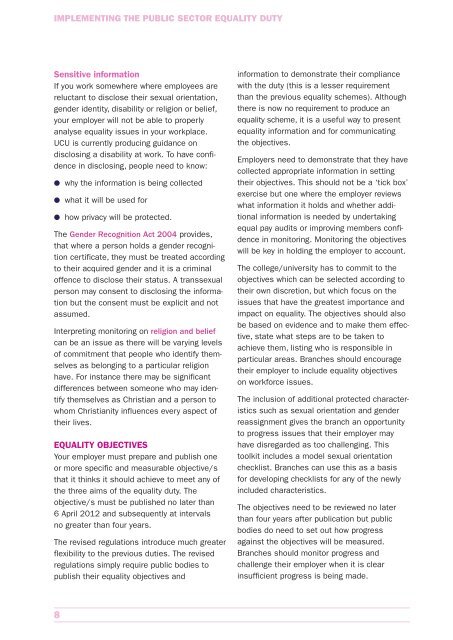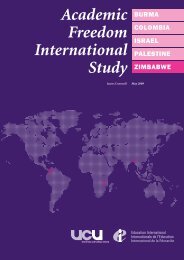Implementing the public sector equality duty - UCU
Implementing the public sector equality duty - UCU
Implementing the public sector equality duty - UCU
Create successful ePaper yourself
Turn your PDF publications into a flip-book with our unique Google optimized e-Paper software.
IMPLEMENTING THE PUBLIC SECTOR EQUALITY DUTYSensitive informationIf you work somewhere where employees arereluctant to disclose <strong>the</strong>ir sexual orientation,gender identity, disability or religion or belief,your employer will not be able to properlyanalyse <strong>equality</strong> issues in your workplace.<strong>UCU</strong> is currently producing guidance ondisclosing a disability at work. To have confidencein disclosing, people need to know:l why <strong>the</strong> information is being collectedl what it will be used forl how privacy will be protected.The Gender Recognition Act 2004 provides,that where a person holds a gender recognitioncertificate, <strong>the</strong>y must be treated accordingto <strong>the</strong>ir acquired gender and it is a criminaloffence to disclose <strong>the</strong>ir status. A transsexualperson may consent to disclosing <strong>the</strong> informationbut <strong>the</strong> consent must be explicit and notassumed.Interpreting monitoring on religion and beliefcan be an issue as <strong>the</strong>re will be varying levelsof commitment that people who identify <strong>the</strong>mselvesas belonging to a particular religionhave. For instance <strong>the</strong>re may be significantdifferences between someone who may identify<strong>the</strong>mselves as Christian and a person towhom Christianity influences every aspect of<strong>the</strong>ir lives.EQUALITY OBJECTIVESYour employer must prepare and publish oneor more specific and measurable objective/sthat it thinks it should achieve to meet any of<strong>the</strong> three aims of <strong>the</strong> <strong>equality</strong> <strong>duty</strong>. Theobjective/s must be published no later than6 April 2012 and subsequently at intervalsno greater than four years.The revised regulations introduce much greaterflexibility to <strong>the</strong> previous duties. The revisedregulations simply require <strong>public</strong> bodies topublish <strong>the</strong>ir <strong>equality</strong> objectives andinformation to demonstrate <strong>the</strong>ir compliancewith <strong>the</strong> <strong>duty</strong> (this is a lesser requirementthan <strong>the</strong> previous <strong>equality</strong> schemes). Although<strong>the</strong>re is now no requirement to produce an<strong>equality</strong> scheme, it is a useful way to present<strong>equality</strong> information and for communicating<strong>the</strong> objectives.Employers need to demonstrate that <strong>the</strong>y havecollected appropriate information in setting<strong>the</strong>ir objectives. This should not be a ‘tick box’exercise but one where <strong>the</strong> employer reviewswhat information it holds and whe<strong>the</strong>r additionalinformation is needed by undertakingequal pay audits or improving members confidencein monitoring. Monitoring <strong>the</strong> objectiveswill be key in holding <strong>the</strong> employer to account.The college/university has to commit to <strong>the</strong>objectives which can be selected according to<strong>the</strong>ir own discretion, but which focus on <strong>the</strong>issues that have <strong>the</strong> greatest importance andimpact on <strong>equality</strong>. The objectives should alsobe based on evidence and to make <strong>the</strong>m effective,state what steps are to be taken toachieve <strong>the</strong>m, listing who is responsible inparticular areas. Branches should encourage<strong>the</strong>ir employer to include <strong>equality</strong> objectiveson workforce issues.The inclusion of additional protected characteristicssuch as sexual orientation and genderreassignment gives <strong>the</strong> branch an opportunityto progress issues that <strong>the</strong>ir employer mayhave disregarded as too challenging. Thistoolkit includes a model sexual orientationchecklist. Branches can use this as a basisfor developing checklists for any of <strong>the</strong> newlyincluded characteristics.The objectives need to be reviewed no laterthan four years after <strong>public</strong>ation but <strong>public</strong>bodies do need to set out how progressagainst <strong>the</strong> objectives will be measured.Branches should monitor progress andchallenge <strong>the</strong>ir employer when it is clearinsufficient progress is being made.8





![(.pdf) [29kb] - UCU](https://img.yumpu.com/50914942/1/184x260/pdf-29kb-ucu.jpg?quality=85)










